The simplest way to keep yourself—and others—safe
Mom and Dad always said it—and they were right: Wash your hands. The practice rinses away garden-variety bad bacteria like E. coli and salmonella, both of which are common food poisoning triggers; it can also save you from cold and flu viruses, not to mention scary things like coronavirus. But if you don’t wash properly, you’re putting yourself at risk. Don’t make these mistakes.

You don’t wash long enough
A study from Michigan State University study published in the Journal of Environmental Health found that 95 percent of people don’t wash hands long enough to effectively kill germs—that’s 20 seconds of scrubbing with soap and water, according to the Centers for Disease Control and Prevention. “We tell kids and adults to sing the ‘Happy Birthday’ song twice,” says Roshini Raj, MD, a clinical associate professor in the Department of Medicine at NYU Langone Health. The average hand-washing time was only about six seconds, the MSU study found. What’s more, 15 percent of men and 7 percent of women didn’t wash their hands at all after using the restroom. Besides washing your hands properly, here are some more things you need to clean regularly.

You skip nooks and crannies
If you just rub soap between your palms, rinse, and call it a day, your hands are probably still dirty. “Germs love to hide under fingernails and in the pockets between fingers, so you should scrub these areas every time you wash,” says Dr. Raj. Be sure to scrub vigorously to work up a good lather—friction is key to eliminate dirt, grease, and microbes from the skin.

You don’t dry thoroughly
The most diligent handwashing techniques are worthless if you skimp on drying. Germs love to breed in moisture, says Dr. Raj. Leaving the restroom with still-damp hands can make it easier to pick up germy microbes from the next surface you touch. If you have the choice of paper towels or air blowers, choose the paper towels. In a review of handwashing studies dating back to the 1970s, researchers concluded that paper towels are superior to driers at getting hands properly dry without spattering germs or drying out skin (the review was published in Mayo Clinic Proceedings). If blowers are your only option, be sure to spend enough time with your hands under the blowing air until they’re completely dry, even if it takes a while.

You wash only after using the bathroom
Anytime you touch a public surface—elevator buttons, a doorknob, the ATM, or a subway pole—you’re at risk for picking up germs or bacteria. “Most people know to wash after going to the bathroom, but you should wash periodically throughout the entire day, especially during cold and flu season,” says Dr. Raj. For times when it’s not convenient to get to a sink, stash a bottle of hand sanitizer in your car, bag or desk drawer. A sanitizer with an alcohol content of at least 60 percent is effective at killing many types of germs, says the CDC. (Find out how long hand sanitizer actually lasts.)

You assume you have to use hot water
Soap and hot water is one tip from Mom you can safely ignore. Dr. Raj says that despite the widespread belief that you need hot water to kill hand germs, lukewarm or even cold water will do the job just as well. (In fact, they’re actually better for your skin because they’re less drying). She notes that while heat has been proven to kill bacteria, you’d need to use boiling water at a temp of about 212 degrees Fahrenheit to see a significantly greater reduction in pathogens. Ouch. Make sure you never make these bathroom mistakes again.
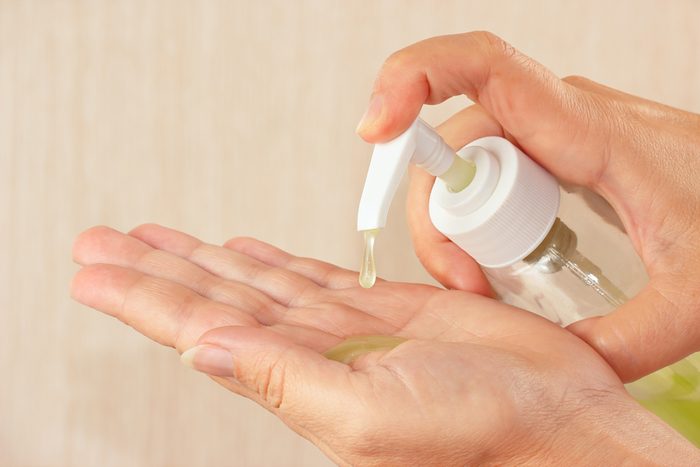
You skip the soap and use hand sanitizer instead
If your hand sanitizer is alcohol-based, it can remove and inactivate many types of microbes effectively, according to the CDC. But it has its limits, warns the organization, like not being able to eliminate all types of germs or harmful chemicals. Plus, many people use hand sanitizer incorrectly from not using a large enough volume of liquid sanitizer to wiping it off before it’s had time to dry. Soap and water are your best bet for fighting off germs like norovirus and Clostridium difficile, a bacteria that can cause diarrhea or life-threatening inflammation of the colon.
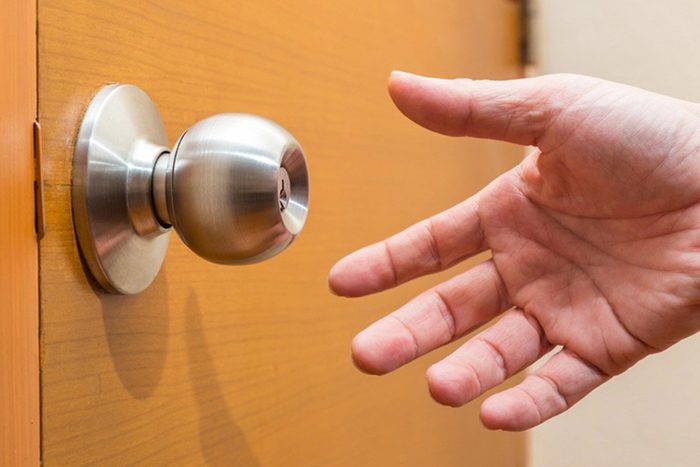
You touch other surfaces immediately after washing your hands
Nothing ruins your hard-earned hand scrubbing more than touching other surfaces right after you wash them. The public health and safety group NSF International (the NSF stands for National Sanitation Foundation) reports their scientists found coliform bacteria—a family that includes E. coli and salmonella—on 75 percent of dish sponges and clothes, 45 percent of kitchen sinks, 32 percent of counter tops, and 18 percent of cutting boards. The bathroom was also problematic: 9 percent of the faucets and 27 percent of toothbrush holders had traces of the bacteria. Since moist surfaces are breeding grounds for germs, it’s best to turn off the tap or open the door in a public restroom with a paper towel to keep your hands clean. Check out these 12 everyday items that are dirtier than your toilet seat.
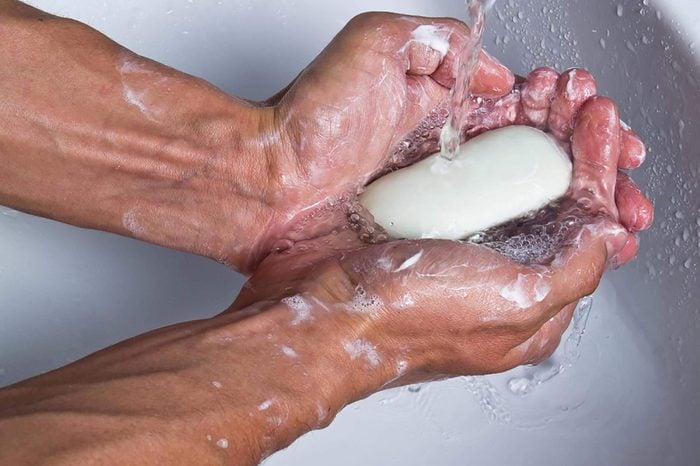
You don’t rinse your bar soap before each use
One study said that pathogenic organisms may hide out on bar soap during and after use, according to the CDC. Research suggests that this bacteria is unlikely to transfer to your hands from the soap during use, but there are extra steps you can take to fully ensure that these germs don’t latch onto your hands. Pathogens like bacteria and viruses can live for several hours on wet soap, says Elaine L. Larson, RN, PhD, an Anna C. Maxwell Professor Emerita and Special Lecturer and a School of Nursing Professor Emerita of Epidemiology at the Mailman School of Public Health, Columbia University. But there’s an easy fix, she points out: “Avoid having bar soap sit in a container in which it will be covered with moisture.” Larson also advises rinsing the bar with running water before you use it. “The germs are generally washed down the drain making it safe to use.” If the soap dries out between uses, you should be fine.
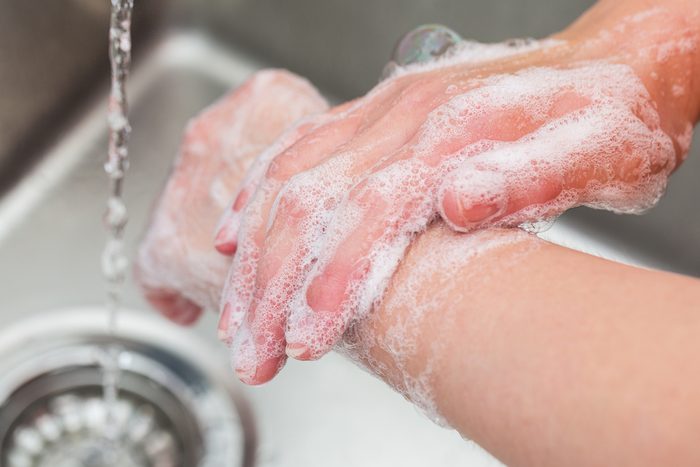
You think antibacterial soap is better than plain soap
There’s no need to grab the antibacterial soap off the drugstore shelf anymore. Very little evidence shows that antibacterial soap is better at preventing illness and the spread of infections better than good old-fashioned soap and water, according to the U.S. Food and Drug Administration (FDA). In fact, the FDA issued a final rule stating that antiseptic wash products (including liquid, foam, gel hand soaps, bar soaps, and body washes) labeled “antibacterial” with ingredients like triclosan will no longer be on the market since the manufacturers haven’t proven the effectiveness or safety of using these ingredients over an extended period of time. Some studies have shown that triclosan may increase antibiotic resistance. The FDA has been urging manufacturers to change the formulas of their products containing 19 of these other active “antibacterial” ingredients or else they’ll no longer be available to consumers. (Bar soap vs. liquid soap: here’s how these two compare.)
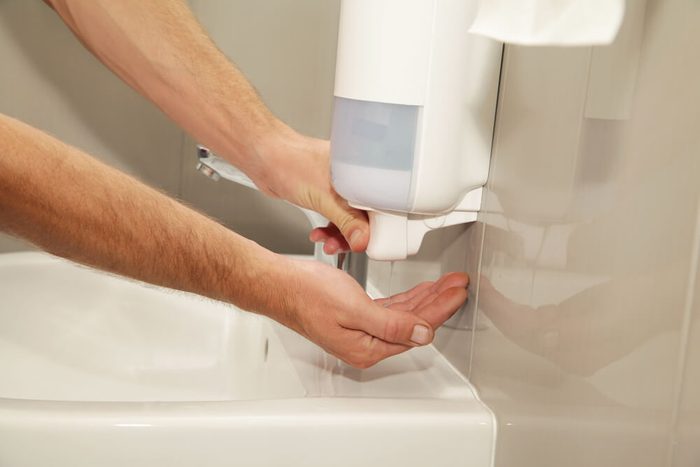
You use soap from a refilled dispenser
You may think that liquid soap dispensers in the bathroom are harmless, but one small 2011 study published in the journal Applied and Environmental Microbiology found that, in an elementary school bathroom, soap dispensers refilled from a large liquid soap bottle can lead to a 26-fold increase in bacteria on your hands compared to soap dispensers that have been replaced with a sealed refill. You’ll be surprised to find that the soap dispensers replaced with sealed liquid soap refills actually showed a significant decrease in bacteria! If you’re weary of the soap in a public bathroom, bring a travel-sized bottle of soap with you instead. Now that you know how you should be washing your hands, read about the 6 body parts you need to stop cleaning so much.